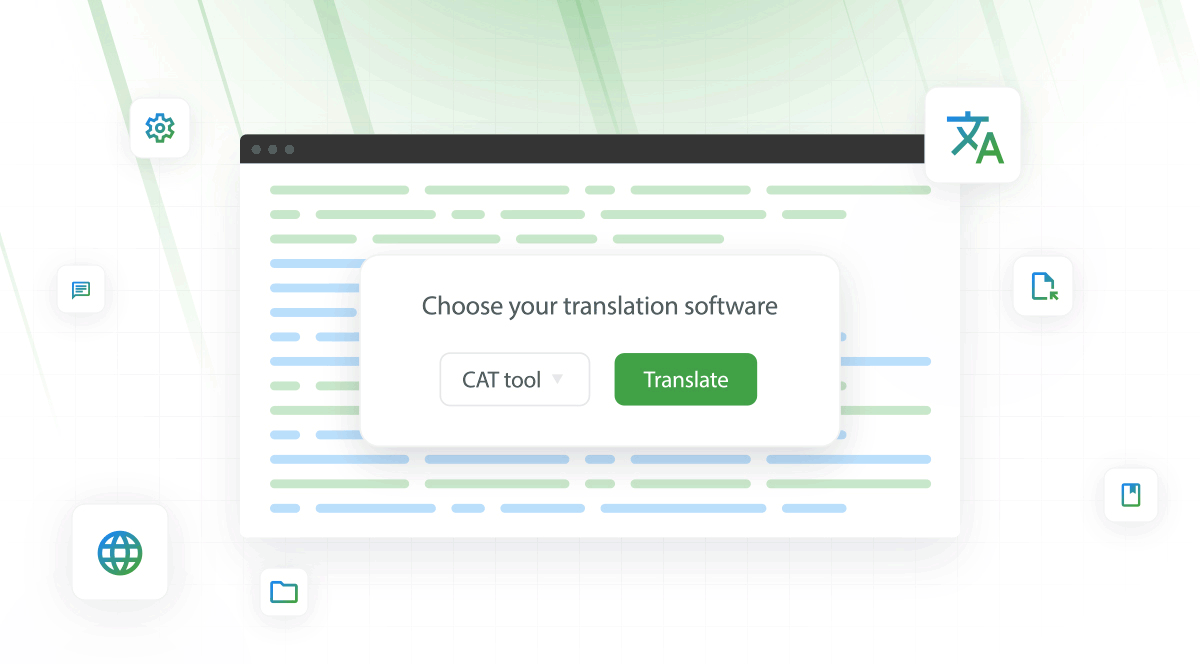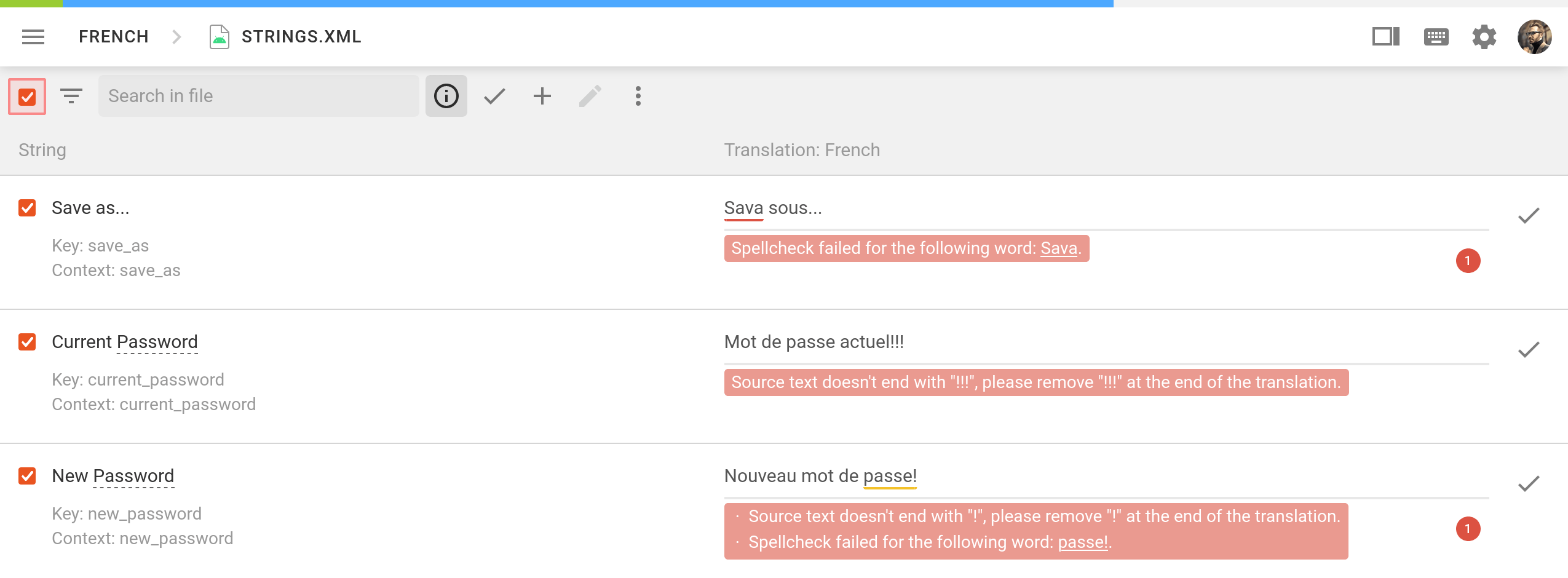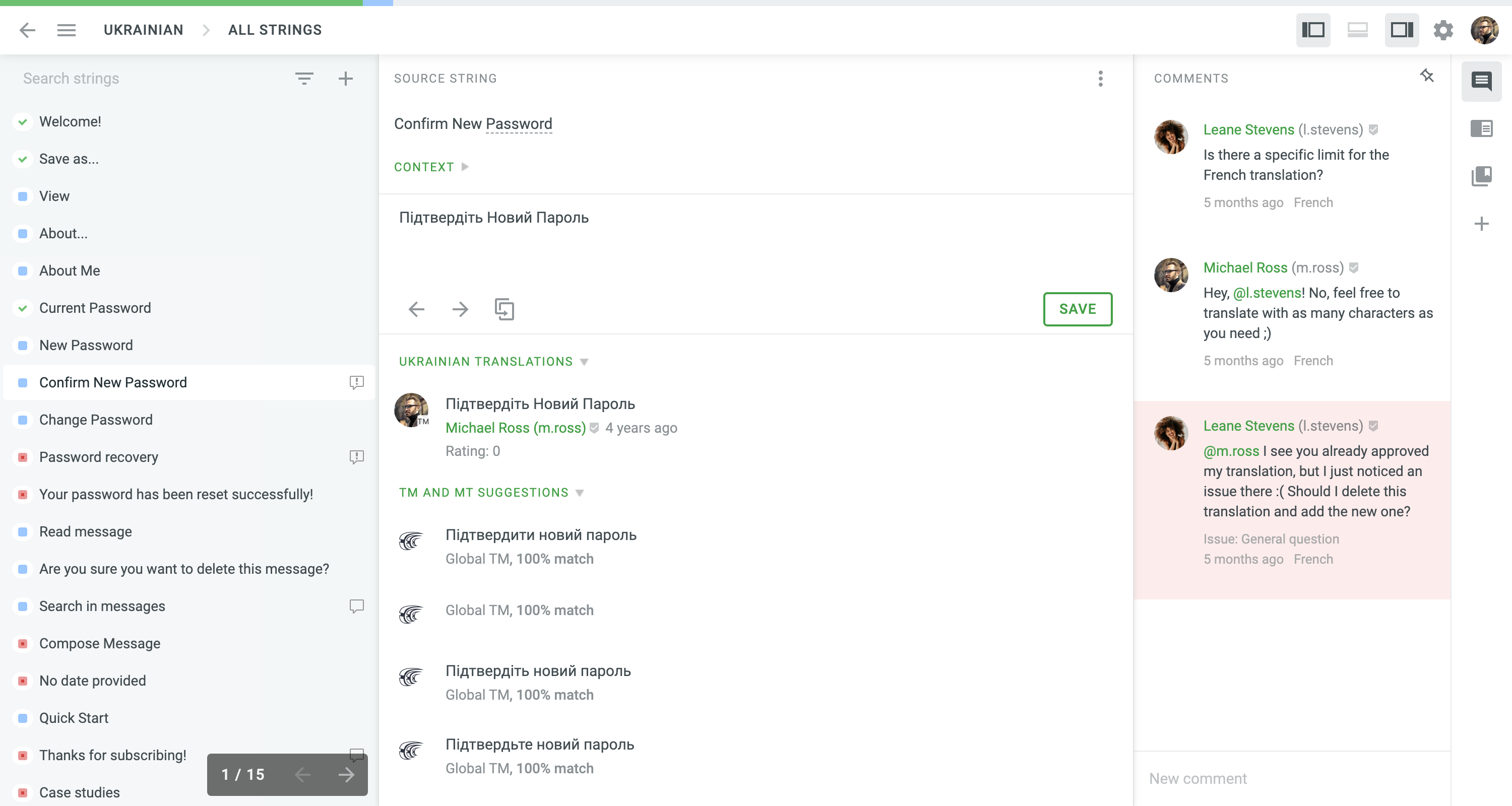
In this article, we will introduce the realm of CAT tools, exploring their capabilities, benefits, and the role they play in bridging linguistic gaps and enabling effective communication on a global scale. Whether you’re a translator, a project manager, or simply curious about the world of language technology, read on to discover how CAT software can help you with translation and localization.
What are CAT tools?
A computer-assisted translation tool is software designed to aid human translators. CAT tool doesn’t replace the translator but helps them work more effectively. The fundamental concept behind CAT software is that it allows translators to work more efficiently and provide consistent, relevant translations using a translation editor. Mainly, translators work with smaller, manageable units, often sentences or paragraphs, making the translation process more organized.
Main Types of CAT Software
Let’s take a look at the main differences, target users, and things to keep in mind.
Desktop-Based
Desktop tools are installed on an individual user’s computer, providing offline access. Typically, freelance translators and translation agencies use them. The main advantage: you don’t need the internet to work. The main disadvantage: you can only work from one device or share a link to the string or file in question with your colleagues.
Cloud-Based
Cloud-based tools are hosted on remote servers and accessed through your browser. They are the right decision if you need collaboration and work in a remote environment. This software offers accessibility from any device with an internet connection, real-time collaboration between translators and project managers, and automatic updates without requiring manual installation. The main advantage: you can work from any browser and device, and you can collaborate with your team online. The main disadvantage: you need a stable internet connection.
Hybrid
Some of the tools may have hybrid approaches. They allow users to work offline with cloud synchronization capabilities when an internet connection is available. For example, Crowdin is a cloud-based localization software, but managers can enable offline access for translators. This approach is supported but not recommended since translators might translate the same segments without noticing that. Translating online is a better option since people working on the same project will see real-time progress.
Key Features of CAT Tools
The main goal of computer-assisted translation (CAT) tools is to provide translators with features that improve translation efficiency and consistency. Each tool might call the same features differently, but the core functionality is the same for tools in this category. For example, you might see Glossary and Termbase features, essentially the same thing.
Translation Memory (TM)
Translation memory is one of its fundamental features. It stores previously translated segments (sentences, phrases, or even individual words) and their corresponding translations. When a similar or identical segment reappears in a new document, your CAT tool can suggest the previous translation or add it right away. The translator can accept, modify, or reject TM’s suggested translation. This way, you won’t need to translate the same thing again.
Terminology Management
CAT tools allow users to create and manage localization glossaries or terminology databases. Translators have access to terminology glossaries created within the CAT tool. These glossaries ensure consistent usage of industry-specific or client-specific terms.

File Format Support
Most tools support popular localization file formats, so you don’t have to worry whether they will support your files. The most common file formats include json, xliff, xlsx, csv, xml, yaml, properties, and many more. Some tools might be tailored to support just one or a few file formats, so if you’re planning to scale your localization project eventually – make sure the tool you choose will allow that.
Quality Assurance Checks
Built-in QA checks identify potential issues such as spelling errors, grammar mistakes, formatting mistakes, and inconsistencies. Translators can address these issues during translation, or the editor can fix them in the review step.

There are also industry-standard metrics that help you evaluate translation quality, for example:
- TAUS DQF-MQM Model
- LISA Model
- SAE J2450 Model
Some tools support them as an add-on to analyze the translation quality.
Collaboration and Versioning
This works best when your CAT tool can work in the cloud. This way, you can discuss strings online, split files for translation, check translation progress, and see what’s going on right away. Everyone is working on the same files and has access to the same resources. There are no more source-file1.xml, source-file1-copy.xml, source-file1-copy-latest.xml, and version issues.
Online tools, like Crowdin, allow you to update your current files, so you can add those 20 new strings without creating a whole new project. All the translated strings will remain translated – you will have to get the 20 new ones translated with no additional work. All the translators will get access to the updated file, not the old versions.
Multiple Language Support
CAT tools typically do not limit the number of languages you can translate into, but even if the language is not supported by default, you can add custom languages. Language settings influence how the translation files will be exported, so make sure your CAT tool supports the export options you need. Translation files can use different language codes. For example:
- Two-letter code: en for English, fr for French.
- Three-letter code: eng for English, fra for French
- Country codes: en_US for American English, en_GB for British English, and fr_CA for Canadian French.
Data Security
The CAT tool you choose should prioritize data security and comply with data protection standards, ensuring the confidentiality of sensitive content. The primary security standards to check for:
- GDPR Compliance
- ISO 27001
- HIPAA
Also, the tool can offer application security features such as IP allowlist, SSO, 2FA, REST API, role-based permissions, granular access, and versioning.
Download Free E-book About Continuous Localization
How CAT Software Works
Here’s a look at the typical workflow when using CAT tools for translation.
Project Setup
Begin by creating a new translation project. Define the project’s source and target languages, your translation strategy and team, type of content, and deadlines, if any.
Document Import
Import the source files that need translation into the CAT tool. You can upload files manually using API or integrations.
For example, Crowdin has 500+ apps and integrations, so using integrations, you can automate the sync of source files and translation between the tools where your content lives and your translations tool.
CAT tools integrate with content management systems (CMS), development tools, and other software, streamlining localization workflows.
Plugins and integrations can automate various aspects of the localization process, saving time and reducing manual tasks. For example, integrations with content management systems (CMS) and other platforms enable content updates and synchronization.
The translated content is delivered to the client or integrated into the target platform, whether a website, software application, or other content repository.
Segmentation
The CAT software can automatically divide the source content into smaller segments, such as sentences or paragraphs. Segmentation helps translators focus on individual units and ensures context accuracy. This is helpful when translating long-form content, like articles.
Translation
Translators work on translating the source segments into the target language using a user-friendly interface. They may also make use of the translation suggestions provided by the tool.

Review and Collaboration
Collaborative CAT tools allow multiple translators, editors, and proofreaders to work on the same project. Edits and suggestions are synchronized in real-time, facilitating efficient teamwork.
Final Review
After the translation, a final review ensures the content is accurate, consistent, and adheres to project requirements and style guidelines.
Export
The final translated document is exported, typically in the same format as the source document or as specified by the client.
Feedback and Continuous Improvement
CAT tools often provide reporting and analytics to track project progress and translator performance. Feedback is used to improve future projects and maintain translation quality.
Benefits of CAT tools
Here are the key benefits of Computer-Assisted Translation (CAT) tools.
Efficiency and Time Savings
CAT software significantly speeds up the translation process by automating repetitive tasks, leading to faster project completion.
Version Control
Version control allows users to monitor and document all changes and revisions to a translation project.
Crowdin, a cloud-based translation and localization management platform, integrates with popular version control systems like GitLab and GitHub. These integrations enable developers and translators to sync translations with code repositories and maintain version consistency between source code and translations.
Quality Assurance
CAT tools offer quality assurance checks to find and correct errors, such as missing or inconsistent translations, spelling mistakes, and formatting issues.
Cost Savings
CAT tools can significantly reduce the time required for translation, resulting in cost savings for clients.
Over time, the translation memory and terminology databases become valuable assets, reducing the cost of future translation projects.
How to Get the Most from CAT Software
CAT tools are powerful allies for translators and localization teams. To maximize their benefits, consider the following tips.
Choose the Right CAT Tool
Evaluate computer-aided tools based on your needs and project requirements. Consider factors like supported file formats, integration capabilities, and user-friendliness.
Embrace Consistency
Enforce consistent style and formatting guidelines within the tool to maintain a unified voice in your translations.
Customize Settings
Tailor your CAT tool’s settings to align with your workflow. This includes adjusting segmentation rules, QA checks, and auto-correct options.
Collaborate Effectively
Take advantage of real-time collaboration features. Multiple team members can work on the same project simultaneously, increasing efficiency.
Seek Feedback
Encourage open communication among team members. Solicit feedback and collaborate with your team.
Manage Workloads
Use the computer-aided tool to efficiently manage translation project assignments, deadlines, and resource allocation.
Automate Repetitive Tasks
Automate tasks like formatting, segment matching, and concordance searches to save time and reduce the risk of errors.
Document Best Practices
Develop and document internal best practices for using the CAT tool. Share these guidelines with your team to maintain consistency.
By following these tips, translators and localization teams can use the full potential of this software to increase efficiency, maintain translation quality, and deliver exceptional results.
Selecting the Right CAT Tool
Selecting the correct Computer-Assisted Translation (CAT) tool ensures efficient and effective translation and localization processes. Here’s a step-by-step guide to help you make the right choice:
Identify Your Needs
Begin by clearly defining your translation and localization needs. Consider factors like the volume of content, target languages, types of content (e.g., documents, websites, software), and the size of your translation team.
Research Available CAT Tools
Conduct thorough research to identify one that aligns with your needs. Read user reviews and case studies to understand their strengths and weaknesses.
Consider Budget Constraints
CAT tools vary in cost, from free and open-source options to software with the pay-per-seat model or subscription per organization. Evaluate your budget and choose a company that offers a pricing structure suitable for your organization.
Check File Format Compatibility
Ensure the tool supports the file formats commonly used in your projects. It should be versatile enough to handle diverse content types, such as documents, websites, and software.
Assess Collaboration and Project Management Features
Evaluate the collaboration and project management capabilities of the tool. Look for features like real-time collaboration, version control, and task assignment to facilitate teamwork.
Examine Customization Options
Make sure the computer-aided tool allows customization to match your project-specific requirements, including segmentation rules, quality checks, and workflow preferences.
Request Demos and Trials
Many providers offer demos and free trials. Use these opportunities to test the tool’s usability, features, and compatibility with your projects.
Seek User Feedback
Contact peers, colleagues, or online communities for feedback on their experiences with the CAT tools you’re considering. Real-world user insights can be invaluable.
Evaluate Support and Training
Assess the availability of customer support, training resources, and documentation. Ensure that the CAT tool provider offers assistance when needed.
Consider Long-Term Scalability
Choose a computer-assisted translation software that can scale with your organization’s growth and evolving translation needs. It should be adaptable to changing requirements.
Check Data Security and Compliance
Ensure the CAT software provider prioritizes data security and complies with relevant data protection standards, especially when handling sensitive content.
Computer-Assisted Translation VS Translation Management System
CAT and TMS tools are used in translation and localization, but they have different purposes and distinct functionalities.
Computer-Assisted Translation Tools
Focus on Translation
CAT tools primarily focus on aiding translators during translation. They assist human translators in translating text from one language to another.
Segmentation
CAT tools divide the source text into smaller segments (such as sentences or paragraphs) to make it easier for translators to work on individual pieces simultaneously.
Desktop or Cloud-Based
CAT software can be desktop-based or cloud-based. Individual translators or translation teams prefer them.
TMS Tools (Translation Management System)
Project Management
TMS tools are designed to manage the entire translation process, from project initiation to delivery. They focus on project coordination and workflow management.
Resource Management
TMS tools help manage various resources involved in the translation process, including translators, editors, proofreaders, and linguists.
File and Content Management
TMS tools handle file formats, version control, and content storage. They can work with various file types, making them suitable for handling diverse localization projects.
Vendor Management
TMS tools assist in managing translation service providers (vendors) and assigning tasks to them based on their expertise and availability.
Integration
They often integrate with CAT tools, allowing translators to work within a unified environment. TMS tools may also integrate with content management systems and other software used in the localization process.
Reporting and Analytics
TMS tools provide reporting and analytics features to track project progress, costs, and timelines. This helps project managers make informed decisions.
Cloud-Based
Many TMS tools are cloud-based, enabling remote collaboration and real-time project tracking.
Crowdin includes a tool for translators and managers in one place. Benefit from the localization process by using the localization software of the new generation.
Choose your CAT Tool and Start the Localization Process
The right choice requires careful consideration of your project requirements and thoroughly evaluating available options. Researching and testing different tools will help you make an informed decision that aligns with your translation and localization goals.
